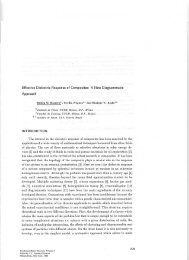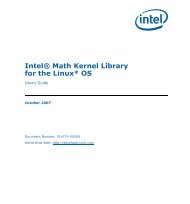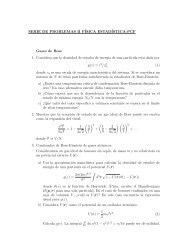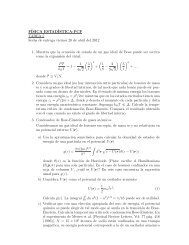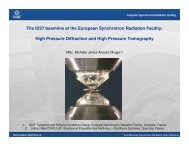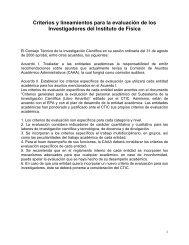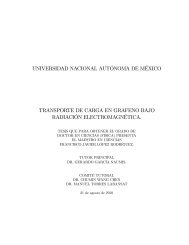Surface Plasmons on Metal Nanoparticles - UNAM
Surface Plasmons on Metal Nanoparticles - UNAM
Surface Plasmons on Metal Nanoparticles - UNAM
Create successful ePaper yourself
Turn your PDF publications into a flip-book with our unique Google optimized e-Paper software.
Feature Article J. Phys. Chem. C, Vol. 111, No. 10, 2007 38111:101:20TABLE 1: Eigenvalues of the SPRs of Prolates and Oblates Spheroids of Different Aspect Ratiosa:c1:21:41:61:8s n L x,L z L x,L z L x,L z L x,L z L x,L z L x,L zprolate 0.1735, 0.4132 0.0754, 0.4623 0.0432, 0.4784 0.0284, 0.4858 0.0203, 0.4898 0.0067, 0.4966oblate 0.2363, 0.5272 0.1482, 0.7036 0.1077, 0.7846 0.0845, 0.8308 0.0695, 0.8608 0.0369, 0.9262In this case, we can easily identify the geometrical factors withthe eigenvalues of the surface proper modes of the spheroid, s n) L γ , and their strength are C γ ) 1/3. Thus, the eigenvaluesare independent of the material properties of the ellipsoid, andthe SPRs are given by the poles of eq 9. Taking into accountthe definiti<strong>on</strong> of the spectral variable, we find that these SPRsfulfill the c<strong>on</strong>diti<strong>on</strong> ɛ(ω)L γ + ɛ h (1 - L γ ) ) 0. Now, it isnecessary to calculate the depolarizati<strong>on</strong> factors L γ .For simplicity, let us c<strong>on</strong>sider ellipsoids generated by therotati<strong>on</strong> of an ellipse around its major or minor axes, whichproduce prolate or oblate spheroids, corresp<strong>on</strong>dingly. Sinceprolate and oblate NPs have a symmetry axis, they have threeproper modes, where two of them are degenerated. Thegeometrical factors L γ for prolate spheroids (a > b ) c) are 74L x ) 1 - e22e 3 (log 1 + e1 - e - 2e )L y ) L z ) 1/2(1 - L x ) and e ) 1 - b 2 /a 2 (10)Whereas for oblate spheroids (a ) b > c), they areL z ) 1 + e2e 3 (e - tan -1 e)L x ) L y ) 1/2(1 - L z ) and e ) a 2 /c 2 - 1 (11)For a sphere (a ) b ) c), it is evident that the depolarizati<strong>on</strong>factors are all degenerated, and to satisfy the sum rule c<strong>on</strong>diti<strong>on</strong>,they must be equal to L x ) L y ) L z ) 1/3, and the SPR fulfillsthe well-known expressi<strong>on</strong> ɛ(ω)L γ + ɛ h (1 - L γ ) ) ɛ(ω) + 2ɛ h) 0.In the previous secti<strong>on</strong>, we found a general behavior of theSPRs, where a red shift of the modes is found when the particleis immersed in a host media, and when interband electr<strong>on</strong>stransiti<strong>on</strong>s are present. To make a closer analysis of the SPRsof el<strong>on</strong>gated NPs and without loss of generality, let us assumethat the NP is immersed in vacuum and its dielectric functi<strong>on</strong>does not c<strong>on</strong>tain c<strong>on</strong>tributi<strong>on</strong>s from interband transiti<strong>on</strong>s, andΓ , ω p , such that ω n ) ω p s n . In this case, the frequency ofthe res<strong>on</strong>ance for the sphere is given by the well-knownexpressi<strong>on</strong> ω n)1 ) ω p 3. Now, let us analyze the case forprolate particles when the semi-axis a goes to ∞, and a cylinderor needle with its axis al<strong>on</strong>g x is obtained. Then, the depolarizati<strong>on</strong>factors are L x f 0, L y ) L z f 1/2, such that, as aincreases, the mode al<strong>on</strong>g the symmetry axis is red-shifted untilit ceases to be visible (zero frequency), while the two perpendicularmodes c<strong>on</strong>verge to ω n ) ω p 2. The other limit case isfor oblates when a and b f ∞ that corresp<strong>on</strong>ds to a flat plateor disk, and the depolarizati<strong>on</strong> factors L x ) L y f 0 and L z f1. Here, the two identical modes al<strong>on</strong>g the symmetry axis cease,since their res<strong>on</strong>ances go to zero as a and b f ∞ while theperpendicular <strong>on</strong>e ω n f ω p . In Table 1, we show the depolarizati<strong>on</strong>factors for prolate and oblates spheroids as a functi<strong>on</strong>of the aspect ratio a:c. We observe that for an aspect ratio a:c) 6:1 (1:6) for prolates (oblates), the limit cases menti<strong>on</strong>edpreviously have been already attained within a 10%.B. Applicati<strong>on</strong> to Gold and Silver NPs. To exhibit thepotentiality of the spectral representati<strong>on</strong>, here, we perform asystematic study of the SPRs of ellipsoidal gold and silver NPsthat are immersed in different media. In the following, we definethe aspect ratio of the NP as the length of the major axis dividedby the width of the minor axis. We will also label the modes asl<strong>on</strong>gitudinal (LM) when they are al<strong>on</strong>g the symmetry axis ofthe particle, whereas transversal modes (TM) are those excitedin the perpendicular directi<strong>on</strong>. Let us c<strong>on</strong>sider gold (Au), andsilver (Ag) NPs with theoretical pω p ) 8.55 and 9.2 eV,respectively. The NPs are embedded in a medium with refracti<strong>on</strong>index n ) ɛ h . For visible wavelengths, the c<strong>on</strong>tributi<strong>on</strong>s ofinterband transiti<strong>on</strong>s can be approximated by a c<strong>on</strong>stant, ɛ inter= 9.9 for Au and ɛ inter = 3.9 for Ag. With these parameters,we calculate the dielectric functi<strong>on</strong> according to eq 4, and usingthe eigenvalues n s from Table 1, and substituting in eq 7, thefrequency of the LM and TM modes of prolate and oblates NPscan be obtained with minimum numerical effort.In Figure 2, we plot the positi<strong>on</strong> of the res<strong>on</strong>ance as a functi<strong>on</strong>of the aspect ratio for gold prolate (left side) and silver oblate(right side) NPs, embedded in vacuum with n ) 1, water/glycerol with n ) 1.3, dimethyl sulfoxide or silica glass with n) 1.47, sapphire with n ) 1.77 or TiO 2 with n ) 2.79. Ingeneral, we c<strong>on</strong>firm that, as the refracti<strong>on</strong> index of the hostmedia increases, all of the modes are always red-shifted. TheLM of prolate particles behaves as the TM of oblate NPs, wherethe positi<strong>on</strong> of the modes is displaced to larger wavelengths asthe aspect ratio increases, although the shift is smaller for oblatesthan for prolates. In the same way, the TM of prolates behavessimilarly to that of the LM of oblates, but now, the modes areshifted to smaller wavelengths when the aspect ratio increases,and this shift is larger for oblates than for prolates. We observethat the LMs and TMs of prolates and oblates, respectively,show a linear behavior independently of the refracti<strong>on</strong> index n,where the slope is modified by n as well as by the particularshape. For instance, the slope of the LMs of prolates is largerthan that of the TMs of oblates. On the other hand, the TM(LM) of prolates (oblates) shows a behavior inversely proporti<strong>on</strong>alto the aspect ratio. The TMs of prolates are always blueshifted,and for aspect ratios between 1 and 3, it occurs rapidly,whereas from 4.5 and larger the limit value is almost reached.Furthermore, the limit value of LMs of oblates is slightly shiftedto large wavelengths as n increases, whereas for prolates thelimit value of TMs is more susceptible to the value of n.The linear behavior of the modes of el<strong>on</strong>gated NPs has beenobserved experimentally and theoretically in nanorods andnanodisks. 59-67 In some of these works, phenomenologicalequati<strong>on</strong>s to determine the positi<strong>on</strong> of the res<strong>on</strong>ances have beenproposed. However, these empirical models can be applied <strong>on</strong>lyto a specific system, where the slope of the linear equati<strong>on</strong>depends <strong>on</strong> the soluti<strong>on</strong> where the particles are dispersed. Onthe other hand, using the expressi<strong>on</strong>s for the eigenvalues givenin eqs 10 and 11, we find an exact dependence of the SPRpositi<strong>on</strong> as a functi<strong>on</strong> of the aspect ratio. For instance, let usc<strong>on</strong>sider the case when the spheroid is nearly spherical (e ,1), such that, the l<strong>on</strong>gitudinal eigenvalues of prolates and oblatesNPs are approximately 74




